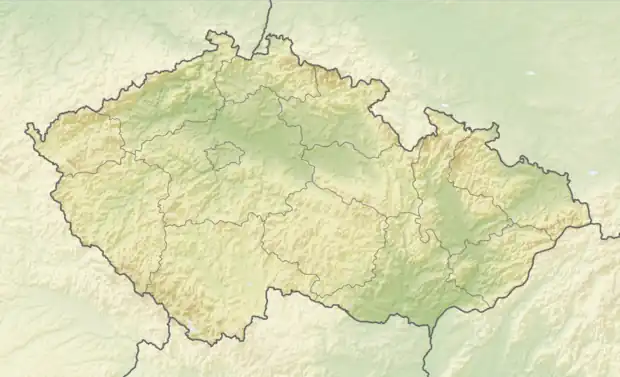Lázně Kynžvart | |
|---|---|
 Church of Saint Margaret in the town centre | |
 Flag  Coat of arms | |
 Lázně Kynžvart Location in the Czech Republic | |
| Coordinates: 50°0′39″N 12°37′29″E / 50.01083°N 12.62472°E | |
| Country | |
| Region | Karlovy Vary |
| District | Cheb |
| First mentioned | 972 |
| Government | |
| • Mayor | Jindřich Zíval |
| Area | |
| • Total | 32.60 km2 (12.59 sq mi) |
| Elevation | 673 m (2,208 ft) |
| Population (2023-01-01)[1] | |
| • Total | 1,514 |
| • Density | 46/km2 (120/sq mi) |
| Time zone | UTC+1 (CET) |
| • Summer (DST) | UTC+2 (CEST) |
| Postal code | 354 91 |
| Website | www |
Lázně Kynžvart (German: Bad Königswart, Königswart) is a spa town in Cheb District, Karlovy Vary Region, Czech Republic. It has about 1,500 inhabitants. It is known for the Kynžvart Castle.
Lázně Kynžvart is famous for its sanatorium, which is designed for children with nonspecific respiratory disorders.
Administrative parts
The hamlet of Lazy is an administrative part of Lázně Kynžvart.
Geography
Lázně Kynžvart is located about 19 kilometres (12 mi) southeast of Cheb and 29 kilometres (18 mi) southwest of Karlovy Vary. There are several minor watercourses and several ponds in the area. The largest ponds are Pastevní and Dvouhrázový.
The southwestern part of the municipal territory lies in the Upper Palatine Forest Foothills, the northeastern part lies in the Slavkov Forest. The highest point is 928 metres (3,045 ft) above sea level. Almost the entire territory belongs to the Slavkov Forest Protected Landscape Area.
History
The first written mention of Lázně Kynžvart is from 972 as Castelum settlement, when it was donated by Otto I, Holy Roman Emperor to bishop Wolfgang of Regensburg. Building of the castle finished in 1287. The castle soon lost its significance, was occupied by a bunch of thieves and in 1348 was burned to the ground by order of the King Charles IV.[2] In 1398 the castle was built once again.[3]
In 1370, after various forms of the town's name were used, the name Königswart was established. The Czech name has been used since 1918.[4]
The Jewish Königswarter family originate in the town.
By World War II, majority of the population were Germans. After they were expelled, the area was resettled by Czechs.
Demographics
|
|
| ||||||||||||||||||||||||||||||||||||||||||||||||||||||
| Source: Censuses[5][6] | ||||||||||||||||||||||||||||||||||||||||||||||||||||||||
Spa
The first mention of springs is from 1454.[7] The spa was founded by the Metternich family, which owned the town's castle.
In 1822, Count Richard Metternich built a spa and six springs around the area. The area shortly became more popular after the spa was built. In 1872, a railway was built, which helped the growth of the spa and the town.[8]
After 1950, during the whooping cough epidemic, children were treated in the spa. Since then, only children were treated in the spa.[7] In 2013, treatment was again extended to adult patients.[8]
Transport
Lázně Kynžvart lies on the main railway line Prague–Cheb via Plzeň.[9]
Sights
.jpg.webp)
The most important monument is the Kynžvart Castle. It was built in the Renaissance style in 1597 and rebuilt at the end of the 17th century. It 1821–1839, it was rebuilt into its current form by the architect Pietro Nobile, in the style of Viennese Neoclassicism.[10] Today the castle is owned by the state and offers guided tours.[11] The castle's collections also include the Kynžvart Daguerreotype, which is protected as a national cultural monument.[12]
The Church of Saint Margaret was originally a Gothic medieval building. It was completely rebuilt in 1870, after it was damaged by a fire.[13]
A notable architectural monument is the spa house called New York. Originally a two-storey house fro mthe second half of the 17th century, it was extended and rebuilt in the late Baroque style in 1770. Today the house is unused.[14]
Notable people
- Klemens von Metternich (1773–1859), Austrian diplomat and nobleman; owned the castle and stayed there
Twin towns – sister cities
Lázně Kynžvart is twinned with:[15]
 Bad Bocklet, Germany
Bad Bocklet, Germany
References
- ↑ "Population of Municipalities – 1 January 2023". Czech Statistical Office. 2023-05-23.
- ↑ "Historie města v datech 972–1356" (in Czech). Město Lázně Kynžvart. Retrieved 2021-06-07.
- ↑ "Historie města v datech 1287–1398" (in Czech). Město Lázně Kynžvart. Retrieved 2021-06-07.
- ↑ "Názvy Kynžvartu v dějinách" (in Czech). Město Lázně Kynžvart. Retrieved 2021-06-07.
- ↑ "Historický lexikon obcí České republiky 1869–2011 – Okres Cheb" (in Czech). Czech Statistical Office. 2015-12-21. pp. 5–6.
- ↑ "Population Census 2021: Population by sex". Public Database. Czech Statistical Office. 2021-03-27.
- 1 2 "Lázně" (in Czech). Město Lázně Kynžvart. Retrieved 2021-06-07.
- 1 2 "Historie léčebných lázní" (in Czech). Léčebné lázně Lázně Kynžvart. Retrieved 2021-06-07.
- ↑ "Detail stanice Lázně Kynžvart" (in Czech). České dráhy. Retrieved 2023-11-03.
- ↑ "Zámek Kynžvart" (in Czech). National Heritage Institute. Retrieved 2023-11-03.
- ↑ "Zámek Kynžvart". Kynžvart Castle. National Heritage Institute. Retrieved 2023-11-03.
- ↑ "Kynžvartská daguerrotypie" (in Czech). National Heritage Institute. Retrieved 2023-11-03.
- ↑ "Kostel sv. Markéty" (in Czech). National Heritage Institute. Retrieved 2023-11-03.
- ↑ "Lázeňský dům New York" (in Czech). National Heritage Institute. Retrieved 2023-11-03.
- ↑ "Partnerská města" (in Czech). Město Lázně Kynžvart. Retrieved 2023-05-24.